The Geography of WATERS
Geography is at the heart of how WATERS works.
Geography considers the physical features, especially the surface features, of a region, area or place. More specifically, the geography of water considers the physical water features, especially the surfacewater features, such as watersheds and the streams, lakes, swamps, etc within watersheds. The framework WATERS uses to integrate EPA Office of Water Program data is based upon this geography of water.
WATERS and the National Hydrography Dataset
Geography attempts to represent the earth's physical features on a map (or in a computer) as points, lines, and polygons. The National Hydrography Dataset (NHD) Plus is a digital (computerized) collection of points, lines and polygons that represent surfacewater features, such as streams, lakes and swamps. Simply put, NHDPlus can be thought of as 'the blue lines on a map'. In fact, NHDPlus includes more than 50 types of surfacewater features found on U.S. Geological Survey topographic maps. The surfacewater features within NHDPlus are further described by associated attributes, including geographic location, type and name (when one exists).
WATERS uses NHDPlus' addressing system to link EPA Water Program features, such as water monitoring sites, to the underlying surfacewater features (streams, lakes, swamps, etc). This linkage enables geographic integration, analysis and display of data stored in different EPA Water Program databases using computer-based tools, such as a Geographic Information Systems (GIS). The NHDPlus addressing system employs a unique, standard identifier, known as the reach code, for each segment of water across the country. Reach codes provide the foundation or common 'language' supporting integrated surfacewater analysis between EPA Water Programs, states, tribes and other users.
EPA Water Program data can be displayed and analyzed geographically. Individual Water Program features are represented as points, lines, and polygons.
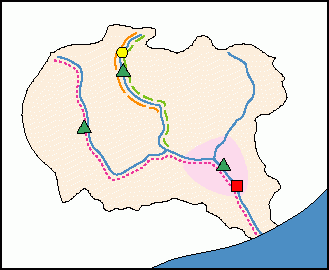
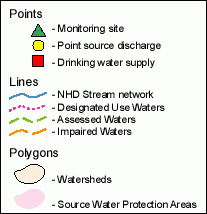
Georeferencing
How is EPA Water Program data linked to NHDPlus?
Georeferencing describes the process of locating an entity in 'real world' coordinates. For example, you could georeference your house by determining its latitude and longitude coordinates. Georeferencing provides the locational component of data. It answers the question 'Where?'.
Another way to georeference your house is to describe its location based on street address.
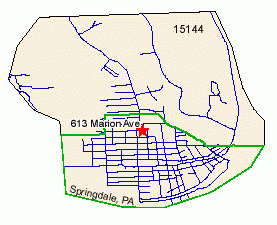

Do you know who grew up in this house?
613 Marion Avenue Springdale, PA 15144
NHDPlus has its own addressing system based upon reaches instead of streets. A reach is the portion of a stream between two points of confluence. A confluence is the location where two or more streams flow together. In the NHDPlus addressing system, a reach code identifies each reach in the same manner that a street name identifies each street. Reach codes are comprised of the 8-digit watershed code followed a 6-digit arbitrarily-assigned sequence number.
Using the reach coding scheme, we can see that watershed 01080105 contains the five reaches:
- 01080105000001
- 01080105000002
- 01080105000003
- 01080105000004
- 01080105000005
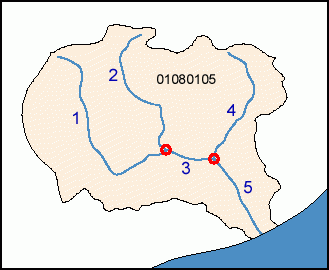

We georeference a Water Program feature by its reach address the same way we georeference a house by its street address. In this sense, a 'water monitoring site on a reach' is just like a 'house on a street'. The reach code serves the same purpose as the street name and the position along the reach serves the same purpose as the house number.
Position along a reach is determined relative to the reach extent. We label the downstream end of a reach as 0% and the upstream end as 100%. If a Water Program feature lies halfway along a reach, its position is 50%.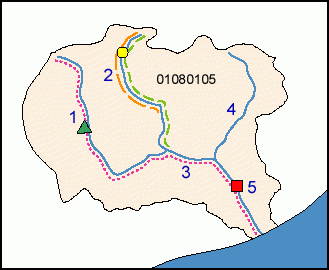
Linear Water Program features are described using both a 'Begin Position' and an 'End Position'. The extent of a linear Water Program feature may span more than one reach, such as the Designated Use Water in this example. In this case, multiple reaches are listed, and begin and end positions are recorded for each reach.
To link EPA Water Program data to NHDPlus, EPA, states and tribes record and store the reach address of each Water Program feature in an EPA database called the Reach Address Database (RAD). Within the RAD, an individual Water Program feature and its associated reach address are recorded in a row in a table similar to the one below. Once the reach addresses have been stored in the RAD, the Water Program databases are logically connected through NHDPlus enabling the sharing of information across Water Programs.
|
Georeferencing Water Program Features to NHDPlus |
||||||
|---|---|---|---|---|---|---|
|
Map Symbol |
Description |
Reach Address |
||||
|
Reach Code |
Begin Position |
End Position |
||||
| Monitoring Site | 01080105000001 | 60% | - | |||
| Point Source Discharge | 01080105000002 | 85% | - | |||
| Drinking Water Supply | 01080105000005 | 55% | - | |||
| Designated Use Water | 01080105000005 01080105000003 01080105000001 |
0% 0% 0% |
100% 100% 100% |
|||
| Assessed Water | 01080105000002 | 0% | 100% | |||
| Impaired Water | 01080105000002 | 30% | 100% | |||
Note: For those of you who are familiar with Geographic Information Systems (GIS) technology or just curious, the NHDPlus addressing system utilizes GIS dynamic segmentation functionality where the reach addresses for Water Program features are implemented as events with NHDPlus reaches serving as the routes and the positions (%) along the reach serving as the measures.
Using WATERS tools, such as MyWATERS Mapper, you can click on an NHDPlus reach and view all the Water Program data linked to that reach.
